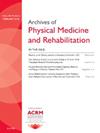基于深度学习的自动穿透-吸气量表评分
IF 3.6
2区 医学
Q1 REHABILITATION
Archives of physical medicine and rehabilitation
Pub Date : 2025-04-01
DOI:10.1016/j.apmr.2025.01.075
引用次数: 0
摘要
目的开发一种能够自动分析穿透-吸吸量表(PAS)的深度学习算法,并展示其准确性。设计回顾性收集资料的分析。三级护理医院。参与者共观看了1039个视频透视吞咽研究(VFSS)视频片段。干预:两名经验丰富的康复医生同意分配PAS分数用于数据编码。在视频的口腔和咽部区域建立感兴趣区域(ROI),设计深度学习模型对PAS进行自动分类。该模型的结构是使用卷积神经网络来寻找roi,该网络提取与roi渗透和吸引相关的视觉特征,并根据这些特征对其进行分类,而无需对视频片段进行进一步的操作。主要测量结果:深度学习算法的预测精度。结果在1039个视频片段中,PAS 1 ~ 8的频率依次为226、145、178、37、137、15、132和129。PAS 4和6因为频率低而被排除在训练之外,而7和8因为在视频中没有被区分而被合并。结果,分类准确率分别为76.09%、42.31%、70.97%、69.23%、75.00%,总体准确率为68.93%。我们已经进行了使用深度学习自动评分PAS的研究,虽然准确率不高,但效果不错。在未来,我们将需要用更多的数据集进行训练,以提高准确性。本文章由计算机程序翻译,如有差异,请以英文原文为准。
Automated Penetration-aspiration Scale Scoring with Deep Learning
Objectives
To develop a deep learning algorithm that can automatically analyze Penetration-aspiration scale (PAS) and present its accuracy.
Design
Analysis of retrospectively collected data.
Setting
Tertiary care hospital.
Participants
A total of 1039 videofluoroscopic swallowing study (VFSS) video clips.
Interventions
Two experienced rehabilitation physicians consensually assigned PAS scores for data coding. Regions of interest (ROI) were established in the oral and pharyngeal regions of the video and deep learning model was designed to automatically classify PAS. The structure of the model was to find ROIs using a convolutional neural network, which extracts visual features related to penetration and aspiration of ROIs and classifies them based on those features without any further manipulation of the video clips.
Main Outcome Measures
Predictive accuracy of the deep learning algorithm.
Results
Out of 1039 video clips, the frequencies for PAS 1 through 8 were, in order, 226, 145, 178, 37, 137, 15, 132, and 129. PAS 4 and 6 were excluded from training due to their low frequency, and 7 and 8 were combined as they were not discriminated in the videos. As a result, the classification accuracy was 76.09%, 42.31% 70.97%, 69.23%, and 75.00%, respectively, and the overall accuracy was 68.93%.
Conclusions
We have conducted research on using deep learning to automatically score PAS and have shown good results, although not high accuracy. In the future, we will need to train with more data sets to improve accuracy.
Disclosures
none.
求助全文
通过发布文献求助,成功后即可免费获取论文全文。
去求助
来源期刊
CiteScore
6.20
自引率
4.70%
发文量
495
审稿时长
38 days
期刊介绍:
The Archives of Physical Medicine and Rehabilitation publishes original, peer-reviewed research and clinical reports on important trends and developments in physical medicine and rehabilitation and related fields. This international journal brings researchers and clinicians authoritative information on the therapeutic utilization of physical, behavioral and pharmaceutical agents in providing comprehensive care for individuals with chronic illness and disabilities.
Archives began publication in 1920, publishes monthly, and is the official journal of the American Congress of Rehabilitation Medicine. Its papers are cited more often than any other rehabilitation journal.

 求助内容:
求助内容: 应助结果提醒方式:
应助结果提醒方式:


